MENAワイヤレスルーター市場:現状分析と予測(2024年~2032年)
タイプ別(シングルバンドワイヤレスルーター、デュアルバンドワイヤレスルーター、トライバンドワイヤレスルーター);および用途別(住宅用および商業用);国
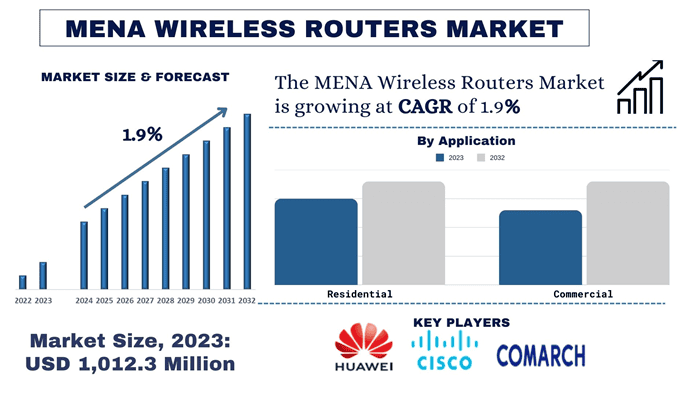
Wi-Fiルーターとも呼ばれるワイヤレスルーターは、ルーターと無線アクセスポイントの機能を組み合わせたネットワークデバイスです。ワイヤレスルーターは通常、インターネットサービスプロバイダー(ISP)のモデムに接続されたイーサネットケーブルを使用してインターネットに接続します。ワイヤレスルーターは、デバイスをインターネットに接続するための物理ケーブルの必要性をなくし、デバイスの配置においてより柔軟性を提供します。
MENAワイヤレスルーター市場は、予測期間(2024年〜2032年)中に1.9%の力強いCAGRで成長すると予想されています。中東および北アフリカ(MENA)のワイヤレスルーター市場は、インターネット普及率、接続デバイスの急増、および高速インターネットに対する需要の増加によって牽引され、着実な成長が見込まれています。消費者は、光ファイバーや5Gなどの高速インターネット接続をますます選択するようになっています。これらの接続には、かなりの帯域幅を効果的に処理できる高度なルーターが必要です。(例:サウジアラビアやUAEなどの国での5Gネットワークの展開は、高性能ルーターの需要を加速させると予想されます)。
市場で活動している主要なプレーヤーには、ABB、Cisco System, Inc.、Comarch SA、Dell Technologies、Hitachi Ltd、HPE、Huawei Technologies Co., Ltd.、IBM Corporation、NTT Communications、Schneider Electricなどがあります。
レポートで提示される洞察
「タイプ別では、デュアルバンドワイヤレスルーターセグメントが2023年に大きな成長を遂げました。」
タイプに基づいて、市場はシングルバンドワイヤレスルーター、デュアルバンドワイヤレスルーター、およびトライバンドワイヤレスルーターにセグメント化されています。デュアルバンドワイヤレスルーターは2023年に市場をリードしました。デュアルバンドルーターは、2.4 GHzと5 GHzの両方の周波数を利用することで、より優れたパフォーマンスを提供します。2.4 GHz帯域はより広い範囲を提供し、5 GHz帯域はストリーミングやオンラインゲームなどの帯域幅を大量に消費するタスクに対してより高速な速度を提供します。
「アプリケーション別では、住宅セグメントが市場で大きな成長を遂げました。」アプリケーションに基づいて、市場は住宅用と商業用にセグメント化されています。住宅セグメントは2023年に市場をリードし、インターネットに接続された世帯数の増加とスマートホームデバイスの採用の増加によって牽引されました。
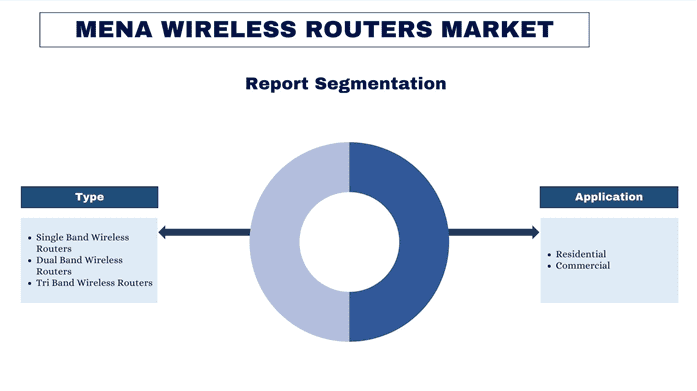
「サウジアラビアは2023年にMENAワイヤレスルーター市場で大きなシェアを占めています。」
サウジアラビアのワイヤレスルーター市場は、以下のようないくつかの要因によって牽引され、今後数年間で著しいペースで成長すると予想されます。
o インターネット普及率の向上:サウジアラビアのインターネット普及率は急速に成長しており、毎年オンラインになる人が増えています。これにより、デバイスをインターネットに接続する方法を必要とするため、ワイヤレスルーターの需要が高まっています。
o 接続デバイス数の増加:世帯あたりの接続デバイス数も急速に増加しています。これには、スマートフォン、ラップトップ、タブレット、スマートTV、その他のデバイスが含まれます。これにより、従来のWi-Fiネットワークに負担がかかり、人々がより新しく、より強力なルーターにアップグレードするようになっています。
o 高速インターネットに対する需要の増加:人々は、光ファイバーや5Gなどの高速インターネット接続をますます要求しています。これらの接続は、従来のDSLまたはケーブル接続よりもはるかに高速な速度を提供できます。ただし、帯域幅の増加に対応できる、より新しく、より強力なルーターも必要になります。
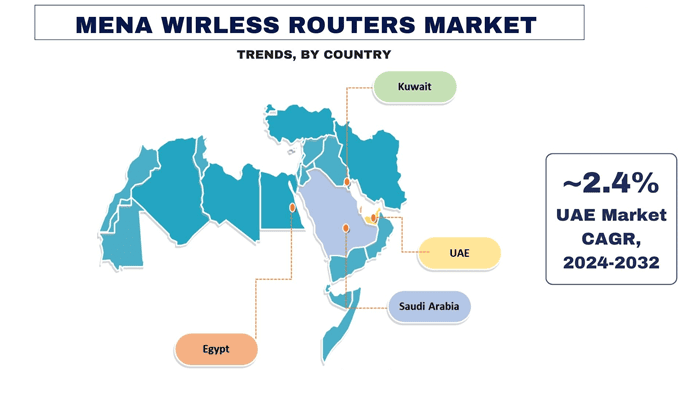
MENAワイヤレスルーター市場レポートの対象範囲
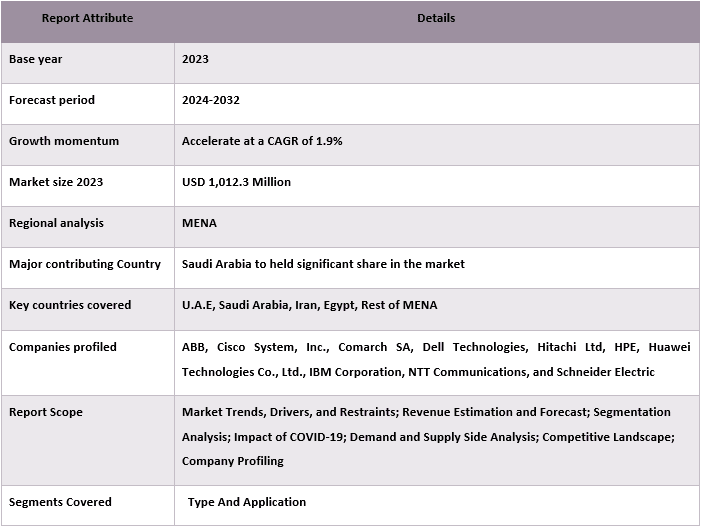
このレポートを購入する理由:
- この調査には、認証された主要業界の専門家によって検証された市場規模と予測分析が含まれています。
- このレポートは、業界全体のパフォーマンスの簡単なレビューを一目で提供します。
- このレポートは、主要なビジネス財務、製品ポートフォリオ、拡張戦略、および最近の動向に焦点を当てて、著名な業界の同業他社の詳細な分析をカバーしています。
- 業界に存在する推進要因、制約、主要な傾向、および機会の詳細な調査。
- この調査は、さまざまなセグメントにわたる市場を包括的にカバーしています。
- 業界の地域レベル分析の徹底的な調査。
カスタマイズオプション:
MENAワイヤレスルーター市場は、要件またはその他の市場セグメントに応じて、さらにカスタマイズできます。これに加えて、UMIは、お客様が独自のビジネスニーズを持っている可能性があることを理解しているため、お客様の要件に完全に適合するレポートを入手するために、お気軽にお問い合わせください。
目次
MENAワイヤレスルーター市場分析のための調査方法
(2024-2032)
MENAワイヤレスルーター市場の過去の市場を分析し、現在の市場を推定し、将来の市場を予測することは、MENA地域におけるワイヤレスルーターの採用を構築および分析するために行われた3つの主要なステップでした。過去の市場数値を収集し、現在の市場規模を推定するために、徹底的な二次調査が実施されました。次に、これらの洞察を検証するために、多数の調査結果と仮定が考慮されました。さらに、MENAワイヤレスルーター市場のバリューチェーン全体にわたる業界の専門家との徹底的な主要インタビューも実施されました。主要なインタビューを通じて市場数値を仮定および検証した後、完全な市場規模を予測するためにトップダウン/ボトムアップアプローチを採用しました。その後、業界に関連するセグメントおよびサブセグメントの市場規模を推定および分析するために、市場の内訳およびデータ三角測量法が採用されました。詳細な方法論は以下で説明されています。
過去の市場規模の分析
ステップ1:二次資料の詳細な調査:
年次報告書と財務諸表、業績プレゼンテーション、プレスリリースなどの企業内部のソースや、ジャーナル、ニュースと記事、政府刊行物、競合他社の刊行物、セクターレポート、サードパーティのデータベース、その他の信頼できる刊行物を含む外部ソースを通じて、MENAワイヤレスルーター市場の過去の市場規模を取得するために、詳細な二次調査を実施しました。
ステップ2:市場セグメンテーション:
MENAワイヤレスルーター市場の過去の市場規模を取得した後、主要地域のさまざまなセグメントとサブセグメントに関する過去の市場の洞察とシェアを収集するために、詳細な二次分析を実施しました。レポートには、タイプやアプリケーションなどの主要なセグメントが含まれています。さらに、その地域におけるテストモデルの全体的な採用を評価するために、国レベルの分析を実施しました。
ステップ3:要因分析:
さまざまなセグメントとサブセグメントの過去の市場規模を取得した後、MENAワイヤレスルーター市場の現在の市場規模を推定するために、詳細な要因分析を実施しました。さらに、再生可能エネルギーに対する需要の増加などの依存変数と独立変数を使用して要因分析を実施しました。MENAワイヤレスルーター市場におけるトップパートナーシップ、合併と買収、事業拡大、製品発売を考慮して、需要と供給側のシナリオの詳細な分析を実施しました。
現在の市場規模の推定と予測
現在の市場規模の算定:上記の3つのステップからの実用的な洞察に基づいて、現在の市場規模、MENAワイヤレスルーター市場の主要なプレーヤー、およびセグメントの市場シェアに到達しました。必要な割合のシェア分割と市場の内訳はすべて、上記の二次的なアプローチを使用して決定され、主要なインタビューを通じて検証されました。
推定と予測:市場の推定と予測のために、利害関係者が利用できる推進要因とトレンド、制約、機会を含むさまざまな要因に重みが割り当てられました。これらの要因を分析した後、関連する予測手法、つまり、トップダウン/ボトムアップアプローチを適用して、MENAの主要市場全体のさまざまなセグメントとサブセグメントの2028年の市場予測に到達しました。市場規模の推定に採用された調査方法論は、以下を含みます。
- 収益(USD)の観点からの業界の市場規模、および国内の主要市場全体でのMENAワイヤレスルーター市場の採用率。
- 市場セグメントとサブセグメントのすべての割合のシェア、分割、および内訳
- 提供される製品の観点からのMENAワイヤレスルーター市場の主要なプレーヤー。また、急速に成長している市場で競争するためにこれらのプレーヤーが採用した成長戦略。
市場規模とシェアの検証
一次調査:主要な地域全体で、トップレベルのエグゼクティブ(CXO/VP、営業責任者、マーケティング責任者、運営責任者、地域責任者、国責任者など)を含む主要オピニオンリーダー(KOL)との詳細なインタビューを実施しました。次に、一次調査の結果を要約し、述べられた仮説を証明するために統計分析を実施しました。一次調査からのインプットは二次調査の結果と統合され、その結果、情報が実用的な洞察に変わりました。
MENA地域におけるワイヤレスルーター市場の主要な利害関係者
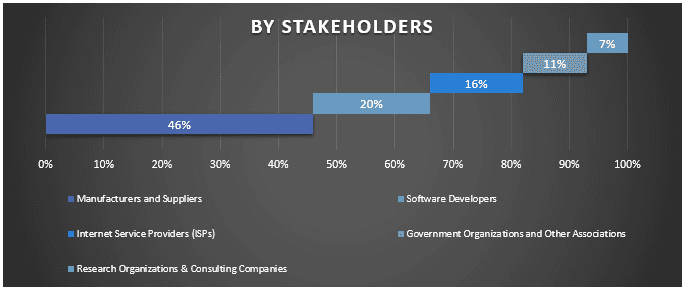
市場エンジニアリング
MENAワイヤレスルーター市場の各セグメントおよびサブセグメントの正確な統計数値に到達し、全体的な市場推定を完了するために、データ三角測量法が採用されました。MENAワイヤレスルーター市場における車両タイプおよびアプリケーションの分野のさまざまなパラメーターとトレンドを調査した後、データはいくつかのセグメントとサブセグメントに分割されました。
MENAワイヤレスルーター市場調査の主な目的
MENAワイヤレスルーター市場の現在および将来の市場トレンドは、調査で正確に指摘されました。投資家は、調査で実施された定性的および定量的分析に基づいて、投資に関する裁量を決定するための戦略的な洞察を得ることができます。現在および将来の市場トレンドは、地域レベルでの市場の全体的な魅力を決定し、産業参加者が未開拓の市場を利用して、先駆者としての利点から恩恵を受けるためのプラットフォームを提供しました。調査のその他の定量的な目標には、以下が含まれます。
- 価値(USD)の観点から、MENAワイヤレスルーター市場の現在および予測市場規模を分析します。また、さまざまなセグメントとサブセグメントの現在および予測市場規模を分析します。
- 調査のセグメントには、タイプやアプリケーションのような領域が含まれます。
- MENAワイヤレスルーターの規制の枠組みを定義および分析する
- さまざまな仲介業者の存在に伴うバリューチェーンを分析するとともに、業界の顧客と競合他社の行動を分析します。
- 主要な地域におけるMENAワイヤレスルーター市場の現在および予測市場規模を分析します。
- MENAワイヤレスルーター市場の企業プロファイルと、急速に成長している市場で持続するために市場プレーヤーが採用した成長戦略。
- 業界の詳細な地域レベルの分析。
よくある質問 よくある質問
Q1: MENAワイヤレスルーター市場の現在の市場規模と成長の可能性はどのくらいですか?
Q2:MENAワイヤレスルーター市場の成長を牽引する要因は何ですか?
Q3: タイプ別でMENAワイヤレスルーター市場において最大のシェアを占めているセグメントはどれですか?
Q4:MENAワイヤレスルーター市場において、どの国が著しい成長を遂げるでしょうか?
Q5:MENAワイヤレスルーター市場で活動している主要なプレーヤーは誰ですか?
関連 レポート
この商品を購入したお客様はこれも購入しました










